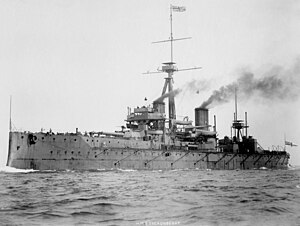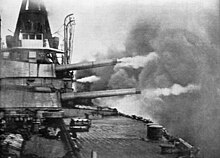Dreadnought
[7] The move to all-big-gun designs was accomplished because a uniform, heavy-calibre armament offered advantages in both firepower and fire control, and the Russo-Japanese War of 1904–1905 showed that future naval battles could, and likely would, be fought at long distances.[17][e] The June 1902 issue of Proceedings of the US Naval Institute contained comments by the US Navy's leading gunnery expert, P. R. Alger, proposing a main battery of eight 12-inch (305 mm) guns in twin turrets.War-game studies begun in July 1903 "showed that a battleship armed with twelve 11-or-12-inch (279 or 305 mm) guns hexagonally arranged would be equal to three or more of the conventional type.[22] Part of the rationale for the decision to retain mixed-calibre guns was the need to begin the building of the ships quickly because of the tense situation produced by the Russo-Japanese War.When the US was considering whether to have a mixed-calibre main armament for the South Carolina class, for example, William Sims and Poundstone stressed the advantages of homogeneity in terms of ammunition supply and the transfer of crews from the disengaged guns to replace gunners wounded in action.[f] Some historians today hold that a uniform calibre was particularly important because the risk of confusion between shell-splashes of 12-inch and lighter guns made accurate ranging difficult.[h] The newer designs of 12-inch gun mounting had a considerably higher rate of fire, removing the advantage previously enjoyed by smaller calibres.The specification for the new ship was a 12-inch main battery and anti-torpedo-boat guns but no intermediate calibres, and a speed of 21 kn (24 mph; 39 km/h), which was two or three knots faster than existing battleships.After a full evaluation of reports of the action at Tsushima compiled by an official observer, Captain Pakenham, the Committee settled on a main battery of ten 12-inch guns, along with twenty-two 12-pounders as secondary armament.The greater power and lighter weight of turbines meant the 21-knot design speed could be achieved in a smaller and less costly ship than if reciprocating engines had been used.This was also a carry-over from the older tactical doctrine of continuously closing range with the enemy, and the idea that gunfire alone may be sufficient to cripple a battleship, but not sink it outright, so a coup de grace would be made with torpedoes.[52] By the middle of World War II, the United Kingdom was making use of 15 in (380 mm) guns kept as spares for the Queen Elizabeth class to arm the last British battleship, HMS Vanguard.For example, armour schemes were changed to reflect the greater risk of plunging shells from long-range gunfire, and the increasing threat from armour-piercing bombs dropped by aircraft.Burning coal as fuel also produced thick black smoke which gave away the position of a fleet and interfered with visibility, signaling, and fire control.The United Kingdom planned to revert to mixed firing with the subsequent Revenge class, at the cost of some speed—but Fisher, who returned to office in 1914, insisted that all the boilers should be oil-fired.With the signing of the Entente Cordiale in April 1904, it became increasingly clear the United Kingdom's principal naval enemy would be Germany, which was building up a large, modern fleet under the "Tirpitz" laws.The British ships were faster and more powerful than their German equivalents, but a 12:10 ratio fell far short of the 2:1 superiority the Royal Navy wanted to maintain.[94] In 1909, the British Parliament authorized an additional four capital ships, holding out hope Germany would be willing to negotiate a treaty limiting battleship numbers.The United Kingdom responded by laying down ten new super-dreadnoughts in its 1912 and 1913 budgets—ships of the Queen Elizabeth and Revenge classes, which introduced a further step-change in armament, speed and protection—while Germany laid down only five, concentrating resources on its army.This arrangement gave a broadside equal to Dreadnought, but with fewer guns; this was the most efficient distribution of weapons and proved a precursor of the standard practice of future generations of battleships.[102][103] The two 10-gun, 20,500-ton ships of the Delaware class were the first US battleships to match the speed of British dreadnoughts, but their secondary battery was "wet" (suffering from spray) and their bow was low in the water.An alternative 12-gun 24,000-ton design had many disadvantages as well; the extra two guns and a lower casemate had "hidden costs"—the two wing turrets planned would weaken the upper deck, be almost impossible to adequately protect against underwater attack, and force magazines to be located too close to the sides of the ship.[107] Compared to the other major naval powers, France was slow to start building dreadnoughts, instead finishing the planned Danton class of pre-dreadnoughts, laying down five in 1907 and 1908.[108] In the Navy Estimates of 1911, Paul Bénazet asserted that from 1896 to 1911, France dropped from being the world's second-largest naval power to fourth; he attributed this to problems in maintenance routines and neglect.Two were completed for Brazil: Minas Geraes was laid down on by Armstrong (Elswick) on 17 April 1907, and its sister, São Paulo, followed thirteen days later at Vickers (Barrow).The British Orion class jumped an unprecedented 2,000 tons in displacement, introduced the heavier 13.5-inch (343 mm) gun, and placed all the main armament on the centreline (hence with some turrets superfiring over others).[125] The aforementioned Brazilian dreadnoughts sparked a small-scale arms race in South America, as Argentina and Chile each ordered two super-dreadnoughts from the US and the United Kingdom, respectively.[126][127] Later British super-dreadnoughts, principally the Queen Elizabeth class, dispensed with the midships turret, freeing weight and volume for larger, oil-fired boilers.This was in spite of the ability to engage the enemy at 20,000 yd (18,000 m), ranges where the shells would descend at angles of up to thirty degrees ("plunging fire") and so could pierce the deck behind the outer plate and strike the internal structures directly.[142] In spite of the lull in battleship building during the World War, the years 1919–1922 saw the threat of a renewed naval arms race between the United Kingdom, Japan, and the US.




Growth in size of battleship designs from 1905 onwards, showing the dreadnought's rapid growth between 1905 and 1920, prior to the
Washington Naval Treaty
of 1922















Dreadnought (disambiguation)Royal NavyHMS DreadnoughtUSS Texasmuseum shipbattleshippre-dreadnoughtssteam turbinenaval arms raceUnited Kingdom and Germanyin South AmericaWorld War IWashington Naval TreatyWorld War IIBattle of Jutlandbattlecruiserspre-dreadnoughtcalibrequick-firing gunsBattle of Manila BayImperial Japanese NavySatsumalaid downUSS MichiganRusso-Japanese Warthe Battle of the Yalu RivertorpedoRoyal Navy Mediterranean FleetNaval War CollegeImperial Russian NavyBattle of the Yellow Searange findersBarr & StroudHMS AgamemnonLord Nelson classbarbettesKing Edward VIILord NelsonAndrei PervozvannyKatoriKawachiConnecticutMississippiDantonRegina ElenaRadetzky classesP. R. AlgerBureau of Construction and RepairTheodore RooseveltJ. H. NarbethSouth Carolina classWilliam Simsnaval architectVittorio CunibertiJane's Fighting ShipsRegia MarinaTsushimaFirst Sea LordbattlecruiserCaptain Pakenham12-poundersreciprocating enginesdisplacementtreaty battleshipsBellerophon (1907)main batterypre-dreadnought eraImperial German NavyNassau classtorpedo boatsdestroyerstorpedo tubescoup de graceaction of 27 May 1941HMS RodneyBismarcksuperstructureHelgolandNeptune-class battleshipKaiser classHMS AgincourtsuperfiringOrion classDante AlighieriGangut classTegetthoff classNevada classNelson classYamato classKing George V classRichelieu classBritish 15-inch gunmuzzle velocityNagato-classColorado classN3 classQueen Elizabeth classHMS VanguardH-43 and H-44 designsSuper Yamato12-pounderDreadnought (1906)dual-purpose gunsSMS Bayern"all or nothing" protection schemeYamatoanti-torpedo bulgetorpedo beltpropellerstriple-expansion steam engineCharles Parsonsfuel-efficientNorth DakotaPennsylvania classUSS OklahomaUSS NevadaNew York-class battleshipsFloridaWyominggeared turbineturbo-electricDiesel enginesUSS Mainethermal efficiencystokersthermal content
